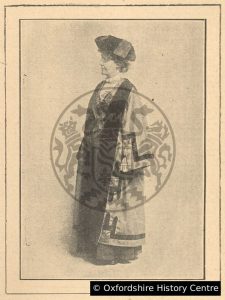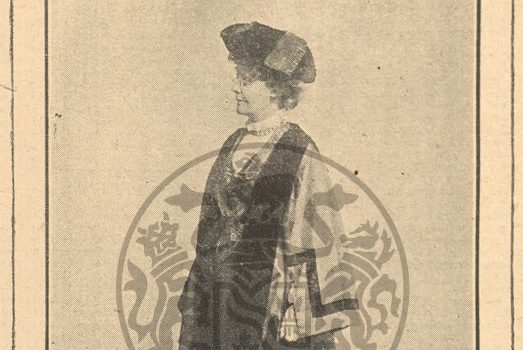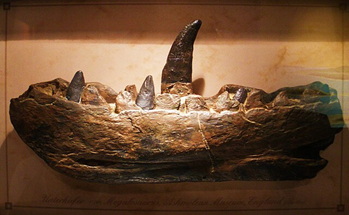This blog post was written and researched by Cllr Katherine Miles.
Want to write your own Oxford-inspired post? Sign up as a volunteer blogger.
Who was the First Female Councillor in Oxford?
International Women’s Day (8 March) is a time to reflect on and promote women’s political participation. In Oxford, the City Council bucks the national trend with equal numbers of female and male councillors, in a wider context in England where only 36% of local councillors are female compared to 64% male.[1] But we know that has not always been the case, and there was a time when there were not only structural and social barriers but legal barriers preventing women’s democratic participation in local government. So who was the first female councillor in Oxford and what do we know about her?
Women were only legally allowed to stand in local elections after the Qualification of Women (County and Borough Councils) Act received Royal Assent on 28 August 1907.[2] The Act removed the disqualification of women from sitting on public bodies for which they were entitled to vote.[3] It provided that a woman shall not be disqualified by sex or marriage for election as a councillor or alderman of a county council or borough council (including metropolitan boroughs).[4] It meant that women could finally stand for election of town and city councils including in Oxford.
In November 1907 elections were to be held three months after the Bill was passed. Outside London seventeen candidates stood for election including Miss Mary Sophia Merivale in Oxford.[5]

Councillor Miss Mary Sophia Merivale. [As appeared in Oxford Journal Illustrated, issue no. 9444, 6 October 1915, page 9. Source: heritagesearch.oxfordshire.gov.uk/images/POX0050125/]
Speakers at the event supported Miss Merivale’s bid for election. One stated it “as a means to promote efficiency…there was great gain in having women brought into places for which they had both knowledge and experience.” Another speaker described Merviale’s candidacy as “a new experiment” and she was “a most excellent and competent candidate”. A third observed that while she was the “women’s candidate” he preferred to think of her as the “children’s candidate” because if children’s interests were to be represented, they must be represented by people who cared for them”.[7]
Merivale was duly elected as a councillor a few days later with an “unexpectedly large majority”.[8] As one of six successful female candidates in England, her election made national news. Notably the press emphasised the social status of these women and their family connections, referencing that Merivale was the daughter of the late Dean Merivale, an Oxford Historian[9], who was best known for his books on the History of the Romans under the Empire.[10] Sadly for Miss Merivale, neither parent was alive to witness her victory, as her father died in 1893[11] and her mother died the year before her election in January 1906.[12]
The Oxford Chronicle covered the story of “Oxford’s First Woman Councillor” and interviewed Miss Merivale on her victory.[13] She was asked whether her success was based on “a desire to have a lady representative on the Council”? She said “No doubt” and that “undoubtedly a large number of lady voters did wish to have a woman representative, and a far larger number of these lady voters attended the poll than ever before”. She also reflected on the “large amount of work for women” to do on the council. Moreover, there was work “particularly related to women and children, in which women’s knowledge ought to be helpful.”[14]
Motivated to represent and bring a woman’s perspective, Miss Merivale is reported to have had a strong sense of what was appropriate and inappropriate council work for a woman in public office. She is said to have refused to join civic deputations to Hastings to inspect their new electric trams on grounds of “decorum”.[15]
The complexities of the debate on women’s representation in politics at the time are illustrated by the fact that while one of the first female councillors, she was known to be “studiously neutral” on the topic of women’s suffrage,[16] and distanced herself from the women’s movement.[17] Yet, Cllr Merivale spoke in hope that she would “soon be joined on the Council by other ladies”.[18
Infant mortality and maternal health were key issues of focus for the first women councillors in England and Cllr Merivale was no exception in taking on these challenges.[19] She became involved in a local Sanitary Association. A key achievement attributed to Cllr Merivale is that she persuaded the Oxford dairy company to provide modified milk for over 100 of their most sickly infants in the city at cost. When infant mortality rates reduced from 94 per thousand in 1908 to 69 per thousand in 1912, Miss Merivale’s health and housing association was given credit for it.[20]
Cllr Merivale went on to represent North Ward for eleven years before resigning her seat on the City Council in November 1918.[21] She lived at 4 Park Town for 34 years before dying on 11 March 1928 aged 75 after a long illness.[22]
In her death announcement, it was reported Cllr Merivale served on the Playgrounds Committee and the Hygiene Committee, the Committee of the Eye Hospital and the Oxford Board of Guardians.[23] An obituary reflected on her achievement as the first female councillor in Oxford: “she won by her strength of character, her modesty and her utter singleness of purposes made the presence of women on the Council acceptable even to those who had most strongly opposed the innovation”. It added that “those who knew her will not readily forget the tall figure with the quick, unconventional speech and the humorous smile that won instant confidence, and will feel that with her a rare spirit has passed away.”[24] Merivale’s funeral took place at St Giles Church and she was interred at Wolvercote Cemetery.[25]
A portrait of Cllr Merivale was installed in the city council chamber as part of the Women on the Wall’s project, to increase the representation of women in portraits in the Oxford Town Hall.
Resources
[1] Based on the latest data at: https://www.oscar-research.co.uk/data-intelligence/genderanalysis.php
[2] https://api.parliament.uk/historic-hansard/commons/1907/aug/12/qualification-of-women-county-and
[3] Ibid.
[4] Hollis, P., 2007, pg 491.
[5] Hollis, P., 2007, pg 396.
[6] Oxford Chronicle and Reading Gazette, 1 November 1907, pg 9.
[7] Ibid.
[8] Oxford Chronicle, November 8, 1907, pg 190.
[9] Aberdeen Press and Journal, Tuesday 5 November 1907, pg 6.
[10] Tablet, 20 January 1900 pg 14.
[11] Cambridge Daily News – Tuesday 14 November 1899, pg 3.
[12] Exeter and Plymouth Gazette – Friday 26 January 1906, pg
[13] Oxford Chronicle, 8 November 1907, pg 190.
[14] Oxford Chronicle, 8 November 1907, pg 190.
[15] Hollis, P., 2007. pg 420.
[16] Hollis, P., 2007. pg 416.
[17] Hollis, P., 2007. pg 410.
[18] Oxford Chronicle, 8 November 1907. Pg 190.
[19] Hollis, P., pg 433.
[20] Hollis, P., pg 438-9.
[21] Oxford Chronicle and Reading Gazette – Friday 28 December 1928, pg 3; Oxford Chronicle and Reading Gazette – Friday 16 March 1928, pg 12.
[22] Oxford Chronicle and Reading Gazette – Friday 16 March 1928, pg 12.
[23] Oxford Chronicle and Reading Gazette – Friday 16 March 1928, pg 12.
[24] The Oxford Magazine, May 3rd 1928 pg 453- 454.
[25] Oxford Chronicle and Reading Gazette – Friday 16 March 1928, pg 12.



